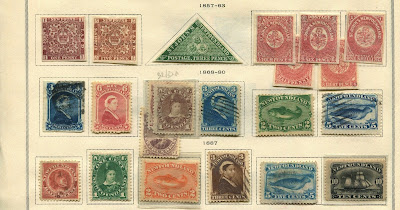Forgeries make collecting Newfoundland dangerous. Not
only are the early stamps forged, often crudely, but bogus copies extend
through to the end of Newfoundland’s stamps for the rarer examples. Some of
these fakes are expensive. Ed Wener has produced a comprehensive guide to the
forgeries, found at: http://www.jacestamps.com/e-books/Newfoundland_Stamps_Fakes_and_Forgeries.pdf.
This 36-page essay can be downloaded. Using Wener’s pointers, I’m in the
process of evaluating my entire Newfoundland collection. For example, I judge
my green three pence triangle to be a genuine #11a. (I’ll post the full results
when I’m finished.) Thankfully, #11a is the least expensive of the green
triangles.
Newfoundland’s variety of youthful Prince of Wales stamps provides and interesting challenge for collectors. Scott assigns seven major numbers to these, plus two minor numbers. But there are only two spaces provided in Big Blue for them. These one cent stamps were intended for mailing newspapers and are often found in “mint” condition but without gum. Actually, they’re used. The post office ordinarily did not cancel stamps on newspapers, so they were easily soaked and sold as mint in the collectors’ market.
New Brunswick #11 black, Newfoundland #s 32 violet, 32a brown lilac,
The first of these (#32, 1868) was designed by the National Bank Note Company (Boston). When the initial supply ran out, replacements were ordered from the American Bank Note Company (New York) which created a new die and used a slightly different color (#32a, 1871). This variety went through several printings, including a rouletted issue (1877). Forgeries by the Spiro brothers and possibly by Oneglia exist, according to Wener, as well as sundry extremely poor efforts, including one in blue. Based on Wener’s descriptions, I think my #s 32 and 32a are genuine.
In 1880 yet another slightly different design was
produced -- this by the British American Bank Note Company (Montreal) -- and
issued in various shades of brown and green. (See #s 41 through 45, 1880-1897).
Wener identifies no forgeries for these, they being perhaps too common to
reward a forger’s efforts.
All of these stamps appear to be inspired by a photo
of the Prince in a Scottish highland outfit (see it in Bud’s Big Blue New
Brunswick post), but there are subtle
engraving differences. Sometimes his tartan sash is secured by a broach,
sometimes not. Sometimes the feather is on the right side of his cap, sometimes
on the left. The tartan pattern, meant to be Royal Stewart and Dress Stewart Saxony,
varies from stamp to stamp. Engravers took their liberties, perhaps working
from earlier stamps rather than the original photo. I wonder if prince, later King
Edward VII, noticed or cared.
Newfoundland stamps are sure to provide collectors
with many entertaining hours. See Jim’s three detailed posts (here) (here)
and (here).
As mentioned above, I intend to reevaluate all my
Newfoundland stamps thanks to Wener’s tutelage. I’m hoping my #s 28a and 31 are
both genuine, but we’ll see….




























As always, this is a very interesting and informative on stamps for Newfoundland. I am wishing you the best in your evaluation of your stamps for forgeries. You presented a really lovely collection of stamps for the province!
ReplyDeleteThanks, album filling. I'll let folks know when I've finished the evaluation.
ReplyDeleteAs always, your posts have educated me and pointed out very worthwhile resources for follow up. The engraving on Newfoundland stamps is superior, they are always pleasing to see. Great post. Thanks!
ReplyDeleteYour kind words are much appreciated.
ReplyDelete